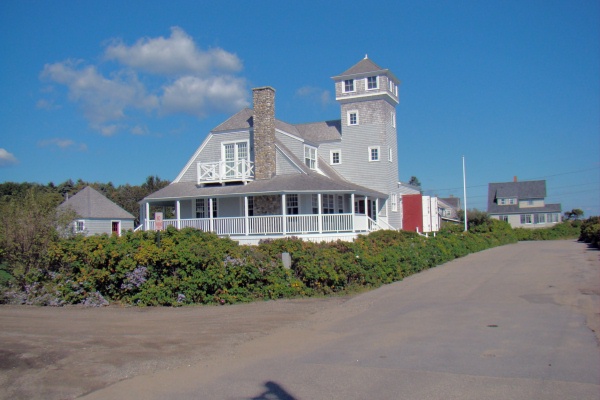NARRAGUAGUS (POND ISLAND) LIGHT, ME. Built in 1853, inactive since 1934, this 31' round, cylindrical granite tower with lantern and gallery is located on Pond Island off Tom Leighton Point, about 5 miles south of Milbridge at the entrance to Narraguagus Bay. The entire site is privately owned, the site and tower are closed. The tower is painted white, lantern black. The 1875 1½-story Victorian wood keeper’s house, an 1887 brick workroom joining the tower to the keeper’s quarters, a 1905 oil house, and two storage buildings survive.
In the 19th century, the little town of Milbridge was an important shipping point for lumber coming from the Narraguagus River. Established by order of President Franklin Pierce in 1853, on the east side of Pond Island to mark the entrance to the harbor of Milbridge, the Narraguagus Light Station first consisted of a short tower and lantern on top of the keeper's dwelling. The pond that gave the island its name is now a swamp.
An inn and clubhouse was built on the island in 1878, and the 3-story Pond Island House continues to operate today. A golf course was added in 1920.
In 1875, a new dwelling was built and much of the original house was removed from around the tower. In 1894, the lighthouse was reinforced with a new layer of brick. The 31-foot granite tower was connected to the keeper's house by a workroom built in 1887. The light that once shown from the tower has been replaced by a buoy located just off Pond Island.
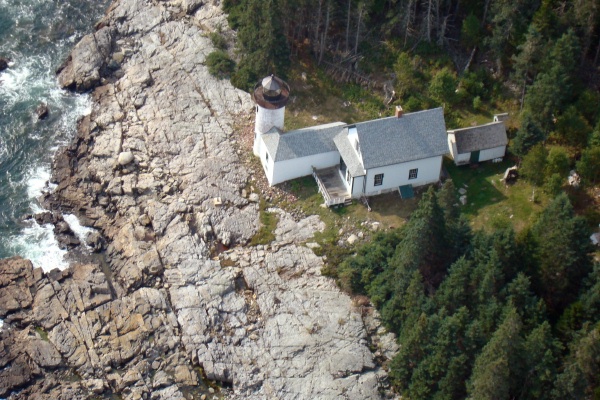
The pilot kept continual contact with the airfields we flew over and knew where the storm was. The flight was uneventful and we felt very comfortable. We did make it to the second light and returned about 10 minutes before the storm came in and the torrential rains began:
LITTLE RIVER LIGHT, ME. Located on Little River Island at the mouth of the Little River near Cutler. Built in 1876, inactive 1980 until 2001, this 41' round, cylindrical cast iron tower (brick lined) with lantern and gallery shows a VRB-25 aerobeacon. The Tower is painted white, the lantern is gray. An 1888 1½-story Victorian wood keeper’s house is under restoration. A 1905 brick oil house and a fog horn that sounds a single blast every 10 seconds survive. The original fog bell tower was demolished, but the bell is on display at a museum in Cutler. Endangered by past neglect, the light station remains on the Doomsday List. Leased in early 2000 by the American Lighthouse Foundation, the Friends of Little River Light was organized and is the site manager. ALF volunteers have rebuilt walkways on the island. The lighthouse was painted in 2001, the lantern windows were reglazed and caulked, and the wood in the lantern interior was replaced. The improvements allowed the Coast Guard to return the light to the tower. The lighthouse was transferred to ALF ownership and restoration of the keeper’s quarters was begun in 2002. In 2006 Coast Guard volunteers painted the lighthouse. The site is closed in the spring and early summer for bird nesting season, but open after July 15th, tower closed.
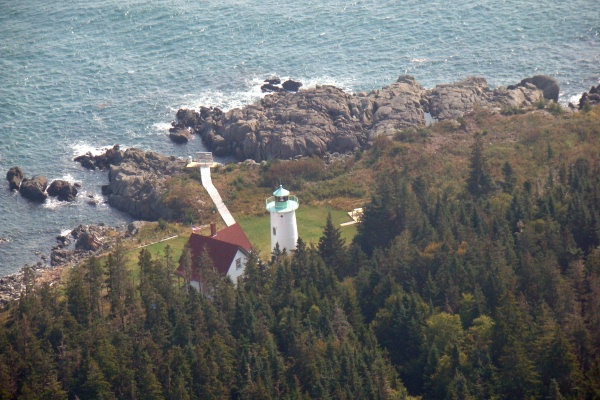
Friday was rainy and foggy–a perfect day for travel. We moved the RV to the Freeport area, arranged for another rental car and planned the next two days of lighthousing. Saturday morning found us on the road around 9 AM. We stopped for breakfast and let the GPS guide us to the first of 8 lights and 1 LSS and 1 Daymark Monument that we’d see and photograph that day:
MARGINAL WAY FAUX LIGHT, ME. This lighthouse is at the end of a popular scenic walk (named Marginal Way) along the shore in Ogunquit, ME. There is a slot in the door for donations to be used for trail maintenance. The trail connects the town of Ogunquit with the harbor known as Perkins Cove. Unable to locate any information as to builder, etc. as of this writing.
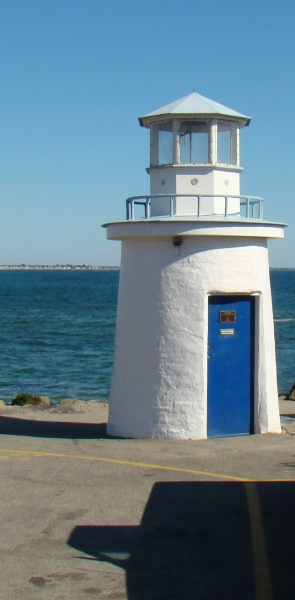
GOAT ISLAND LIGHT, ME. This 1859-built, active, 25' round, cylindrical brick tower with lantern and gallery uses a 300 mm lens for its light source. Its fog horn sounds a single blast every 15 seconds. The tower is painted white, lantern and gallery black. The original 1½-story keeper’s house is occupied in season by a caretaker. The fog bell is on display at the Kennebunkport Historical Society. Buildings are painted white, roofs are red. The station was transferred to the Kennebunkport Conservation Trust in 1998 under the Maine Lights program. A planned restoration will rebuild the bell tower and the walkway between the light tower and keeper’s house. A webcam provides a current view of the lighthouse. Located on an island in the mouth of Cape Porpoise Harbor east of Kennebunkport. Site open, tower closed. Owner/site manager: Kennebunkport Conservation Trust.
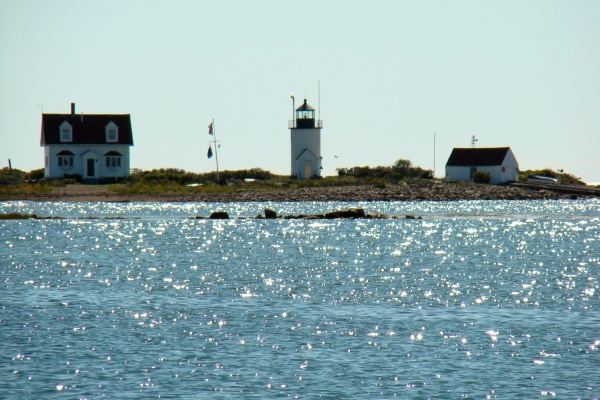
FLETCHER’S NECK (BIDDEFORD POOL) LIFESAVING STATION, ME. Built in 1873, mention is made in the 1905 Lighthouse Board Annual Report that the station was being rebuilt. The Fletcher's Neck Life Saving Station is a Duluth-type station. It was once referred to as the Biddeford Pool Station. The Work Relief and Public Works Appropriation Act of 1938 provided funds to expand the site, construct an equipment building and lookout tower, construct a boathouse and launchway, reshingle the roof of the main building, and repair the heating pipes. The station was still listed as an active station in 1945. The property was turned over to the General Services Administration in 1955. Records indicate a station at Fletchers Neck was closed on October 15, 1971. It has since been beautifully restored and is used as a private residence. It is included in the National Registry of Historic Places.
